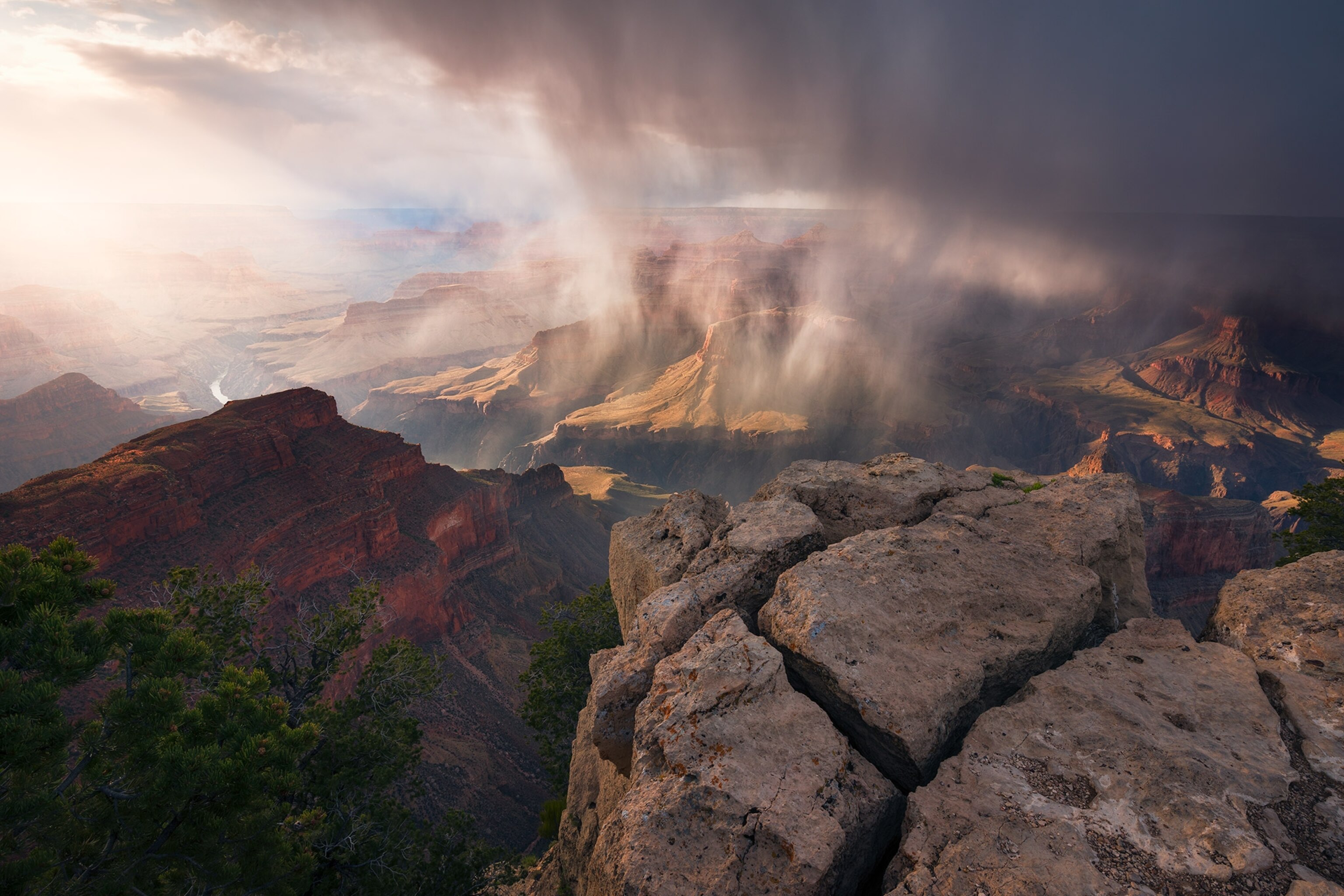










How to take an amazing photo of the Grand Canyon
Get five expert tips from a canyon-lover who’s been photographing the landscape for over a decade.
“You can’t capture the essence of the Grand Canyon in a single photo,” says Adam Schallau.
But that hasn’t kept the award-winning photographer from trying. A former artist-in-residence at Grand Canyon National Park, Schallau has devoted decades to exploring the canyon in his effort to create images that capture the iconic park’s uncompromising beauty. (Discover the Grand Canyon’s less-trafficked trails.)
On one visit, during a stormy week in May, he had a visual breakthrough. “I got to see the light streaming through the clouds—it was full of drama and theatrics,” says Schallau. The experience inspired him to apply to become the park’s artist-in-residence in 2009. Since then, Schallau’s obsession has only grown. He moved from New Mexico to Flagstaff, Arizona, to be closer to the canyon; he rafted the Colorado River through the park, hiked trails between river and rim, and traversed the gorge’s sinuous edges looking for new scenes to capture. He now gives workshops to aspiring photographers, urban youth, and members of the Hopi, Havasupai, and Navajo nations, which border the canyon. (Read how hiking the Grand Canyon is 800 miles of magic and misery.)
Here are Schallau’s top tips for making an epic picture of the Grand Canyon.
Bring a tripod
“Some of the best light occurs before sunrise and after sunset, requiring you to use a long exposure for the best results,” says Schallau. “Take advantage of situations that require a long exposure by using a tripod to stabilize your camera. This can include photographing lightning or the Milky Way. In this photo, I used a 30-second exposure during which lightning struck the canyon multiple times. Thunderstorms make for incredible photos, but always be safe—take shelter when lightning comes within eight to 10 miles of your location. ”

Use a strong foreground
“Step back from the edge and include a foreground to frame the canyon and make the viewer feel like they are there,” Schallau says. “I love to photograph through the trees, using them to outline the canyon, like this photo of Angels Window on the North Rim.”

Go wide
“If you’re lucky enough to participate in a river trip on the Colorado River,” says Schallau, “you’ll get to hike to many waterfalls and slot canyons. You can use a wide-angle lens and get close to your subject, in this case, a waterfall in Elves Chasm near river mile 117. For this photo, I used an ultra-wide-angle lens to emphasize the sweep of the leading lines as they move towards the waterfall.”

Anticipate changes in weather
“Be prepared to capture dramatic light as storms move and shift. The best moments may only last a couple of minutes, and you have to be on the rim ready to capture them,” Schallau explains. “In this photograph, taken from Cape Royal on the North Rim, the sky had been cloudy for several hours. But as sunset approached, the clouds began to clear just as the sunlight broke through.”

Use a telephoto lens
“Use a telephoto lens to zoom in on overlapping layers,” Schallau recommends. “One of my favorite spots is the Desert View Watchtower on the South Rim, where I like to photograph to the west before sunset. There are some beautiful overlapping ridges, including the Angels Gate feature. This same scene can also be beautiful in the morning light when the ridges turn a fiery red as they are lit by the rising sun.”

Related Topics
You May Also Like
Go Further
Animals
- How can we protect grizzlies from their biggest threat—trains?How can we protect grizzlies from their biggest threat—trains?
- This ‘saber-toothed’ salmon wasn’t quite what we thoughtThis ‘saber-toothed’ salmon wasn’t quite what we thought
- Why this rhino-zebra friendship makes perfect senseWhy this rhino-zebra friendship makes perfect sense
- When did bioluminescence evolve? It’s older than we thought.When did bioluminescence evolve? It’s older than we thought.
- Soy, skim … spider. Are any of these technically milk?Soy, skim … spider. Are any of these technically milk?
Environment
- Are the Great Lakes the key to solving America’s emissions conundrum?Are the Great Lakes the key to solving America’s emissions conundrum?
- The world’s historic sites face climate change. Can Petra lead the way?The world’s historic sites face climate change. Can Petra lead the way?
- This pristine piece of the Amazon shows nature’s resilienceThis pristine piece of the Amazon shows nature’s resilience
- Listen to 30 years of climate change transformed into haunting musicListen to 30 years of climate change transformed into haunting music
History & Culture
- Meet the original members of the tortured poets departmentMeet the original members of the tortured poets department
- Séances at the White House? Why these first ladies turned to the occultSéances at the White House? Why these first ladies turned to the occult
- Gambling is everywhere now. When is that a problem?Gambling is everywhere now. When is that a problem?
- Beauty is pain—at least it was in 17th-century SpainBeauty is pain—at least it was in 17th-century Spain
Science
- Here's how astronomers found one of the rarest phenomenons in spaceHere's how astronomers found one of the rarest phenomenons in space
- Not an extrovert or introvert? There’s a word for that.Not an extrovert or introvert? There’s a word for that.
- NASA has a plan to clean up space junk—but is going green enough?NASA has a plan to clean up space junk—but is going green enough?
- Soy, skim … spider. Are any of these technically milk?Soy, skim … spider. Are any of these technically milk?
Travel
- Could Mexico's Chepe Express be the ultimate slow rail adventure?Could Mexico's Chepe Express be the ultimate slow rail adventure?
- What it's like to hike the Camino del Mayab in MexicoWhat it's like to hike the Camino del Mayab in Mexico




